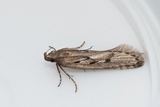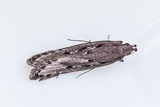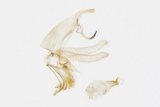Neofaculta ericetella (Geyer, [1832]) Species
Last modified: Nov. 28, 2025, 6:09 p.m.
A common species everywhere in Belgium where heather grows, especially in the Kempen area and the southern part of the country.
Details
- Classification
- Family: Gelechiidae > Subfamily: Anacampsinae > Tribus: Chelariini > Genus: Neofaculta > Species: Neofaculta ericetella
- Vernacular names
- Heidepalpmot (NL), Heather Grey, Heather Groundling, Heather Sober (EN), Heidekraut-Palpenmotte (DE)
- Synonyms
- Neofaculta gallinella (Treitschke, 1833)
- First mention in Belgium
- De Fré Ch. 1858. Catalogue des Microlépidoptères de la Belgique. — Annales de la Société entomologique belge 2: 45–162. On page 131 (as G.[elechia] Gallinella. Tisch.). view page
- Status
-
Native
Distribution
Imago
Wingspan 13–18 mm.
It resembles Neofaculta infernella, but N. ericetella is smaller in size and has a narrower and more greyish forewing, often with whitish admixture. However, worn specimens should be checked for genitalia.
Caterpillar
Head ochreous to pale brown; prothoracic plate dull greyish to whitish green, pair of characteristic dark reddih spots on thoracic segment 2 and 3; abdomen dull greenish with pale dorsal and subdorsal stripes widening posteriorly; pinacula minute and dark grey (Gregersen & Karsholt 2022).
Bionomics
The larva lives at first on the flowers, later in spinnings on the shoots or twigs, forming a shelter where it rests when not feeding. The larva hibernates and continues feeding in spring and later descends to the ground for pupation.
The adults can be disturbed from the food plant during the day and are active from dusk onwards and later come to light.
Flight periods
The adults have been seen from early April towards early September.
Habitat
It inhabits sandy soils where the food plant occurs, but also on raised bogs and cool, damp forest areas.



